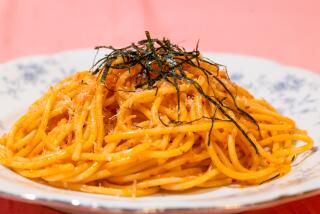Summer Pasta
- Share via
“Everything must bow to pasta cooking: the sauce, the table setting, the guests, the service. Everything. When the pasta hits the water there must be peace, tranquillity, patience and the anticipation of enjoyment. This rule cannot and must not be broken or even bent. Pasta waits for no one under any circumstances.”
--From Carlo Middione, “The Food of Southern Italy”
I like the intransigence of these words, with which I more or less agree. The obvious exception--pasta salad--is pretty much unknown in Southern Italy, a fortunate land where the idea of cold noodles with broccoli in mayonnaise has yet to make much headway.
In this country, for the most part, “spaghetti sauce” still means ground meat and canned tomatoes that have been simmered for hours on end. And in this country, the people who make menus have yet to learn that primavera means spring. But right now, with the late-summer harvest rolling in, none of that need concern us. Fortunately, pasta and fresh vegetables is a concept capable of infinite variety.
Tomatoes are not required--try making a sauce of grilled eggplant mashed with olive oil and lemon, given texture with a few toasted walnuts. Got a lot of sweet bell peppers? Dice them finely, wilt them gently in a thin layer of bacon fat, then toss them with pasta, thinly shredded red onion, and just a bit of Gorgonzola cheese.
On the other hand, why not tomatoes? Why not tomatoes plain, in all their glory? You can make an exquisite summer tomato sauce by sauteing a bit of shallot in a thin film of butter, adding some peeled, coarsely chopped tomatoes, then boiling and stirring them just long enough to drive off the excess liquid.
Allow one shallot, two good-sized, ripe-but-not-soft tomatoes and about 1 1/2 tablespoons of butter per person. Choose a shaped pasta that can catch sauce--rigatoni or spirals, for instance--and be sure to cook the sauce in a wide, shallow pan. Expect lots of sputtering; this is fast, but it isn’t tidy.
Timing is highly variable, but if you put the pasta in the water and start the sauce shortly after, everything should be done at the same time. When the pasta is al dente and the tomatoes have broken down, drain the pasta and pile it on warmed plates. Add the butter to the sauce in a few large pats, tipping the pan gently back and forth until it melts and blends into the tomatoes. Adjust the salt, pour the sauce on the pasta and serve at once, with or without freshly grated cheese.
You might think you’ll be thinner without the butter and so you might be, but the sauce will be thinner too. It won’t stick to the pasta as well and it won’t taste as good.
Most of these suggestions come without the usual recipe apparatus because this, above all, is the time to cook without recipes. Fresh vegetables ought to be easy and fun--just grill them, steam them, or eat them raw. And remember that anything cooked either without fat or with olive oil will taste just as good cold.
This is an ideal way to feed a lot of people, quickly, with the bounty of the late - summer garden. Unlike classic Italian pasta dishes, this one has almost as much sauce as noodles, so be sure to have a loaf of crusty bread to accompany the dish. Meat in the sauce would unbalance the flavors, so if you must have meat to make a meal, serve it as an hors d’oeuvre. Prosciutto and melon would be a good choice, as would garlic sausage and olives, cold smoked chicken . . . anything piquant and salty.
PASTA ESTATE (Summer Pasta)
6 ears corn
1/4 cup olive oil
3 large cloves garlic, finely chopped
1 pound small yellow summer squash, diced 1/2-inch
2 pounds very ripe tomatoes, skinned and coarsely chopped
1 large handful basil leaves, coarsely chopped
1 tablespoon salt
1 pound shell pasta
3/4 pound green beans, preferably flat Romano type, cut in 1-inch lengths
3 tablespoons butter
Freshly grated Parmesan cheese
Heat large kettle of water over high heat. Cut corn kernels from ears into bowl, then scrape cobs over bowl with dull side of knife to extract juice. Place cobs in kettle and boil gently.
Heat oil in deep, wide pan over medium-low heat. Add garlic and cook, stirring, until tender and just starting to turn color, about 5 minutes. Add squash, raise heat to medium-high and stir-fry until squash is cooked through, about 10 minutes. Add tomatoes to skillet along with basil. Reduce heat to low.
Remove corn cobs from water. Add salt to water. Drop in pasta slowly and cook until roughly 2/3 done, about 8 minutes. Add green beans and continue cooking until pasta is al dente and beans are tender. Drain off water, return pasta and beans to pot and stir in butter.
Add reserved corn kernels to tomato-squash sauce. Stir well, then add sauce to pasta pot and toss until combined. Serve at once, accompanied by Parmesan cheese. Makes 6 to 8 servings.
Bill’s Variation:
My partner prefers this dish with generous sprinkling of thinly sliced raw garlic at the time the cheese is added. I regard such treatment as a bit violent, but when the garlic is sweet and new it does have a certain coarse merit.
More to Read
Eat your way across L.A.
Get our weekly Tasting Notes newsletter for reviews, news and more.
You may occasionally receive promotional content from the Los Angeles Times.










